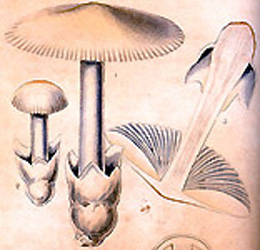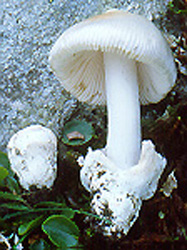|
[ Section Vaginatae page. ] [ Amanita Studies home. ] [ Keys & Checklist/Picturebooks ] Amanita nivalis Grev."Snow Ringless Amanita"
Technical description (t.b.d.) BRIEF DESCRIPTION: Amanita nivalis is is a small species, often white at first, but with its cap taking on grayish and pale ochraceous tints as it matures. The name was not meant to imply that the pileus is always white, but that the species occurred in areas of deep snows -- such as the peaks of the hills of Scotland, from which the original collection came. The cap is 20 - ?0 (-80) mm wide. It may be decorated with small bits of the membranous volva. Its marginal striations occupying one fifth to one third of the cap radius. The white to off-white to cream gills are free or very narrowly connected to the stipe, more or less crowded; and short gills are truncate or rounded truncate, but are usually few and scattered. The stem is 38 - 100 x 5 - 12 (-15) mm, white, and usually exannulate -- although sometimes it bears an ephemeral ring. The stipe has a flaring, saccate, white to pallid ochraceous volva at its base. The spores measure (8.2-) 10.0 - 13.5 (-21) x (7.1-) 8.8 - 12.0 (-19.5) Ám and are globose to subglobose (occasionally broadly ellipsoid, rarely ellipsoid or elongate) and inamyloid. Clamps are not observed at bases of basidia. Amanita nivalis is associated with dwarf willows (Salix) and is a species with alpine and subarctic ranges in Europe and Greenland. The habitats may also include dwarf birch (Betula). Recently, the species has also been reported from high elevations in the Rocky Mountains of western North America with dwarf willows. The variability of spore shape in this species can be confusing -- especially with the
variation in pileus color and the ephemeral decoration of the stipe. Etching: from the plate in Greville's original description (Scotland). [ Section Vaginatae page. ] [ Amanita Studies home. ] [ Keys & Checklist/Picturebooks ] Last changed 7 November 2008. |

